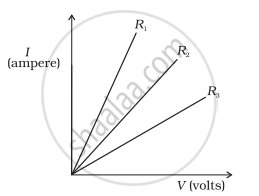Advertisements
Advertisements
Question
Let the resistance of an electrical component remains constant while the potential difference across the two ends of the component decreases to half of its former value. What change will occur in the current through it?
Solution
According to Ohm’s law
V = IR
⇒ I = `V/R` …(1)
Now Potential difference is decreased to half
∴ New potential difference `"Vʹ" = V/2`
Resistance remains constant
So the new current `"Iʹ" = "Vʹ"/"R"`
= `(V/2)/R`
= `(1/2) (V/R)`
= `(1/2) I`
= `I/2`
Therefore, the amount of current flowing through the electrical component is reduced by half.
APPEARS IN
RELATED QUESTIONS
A low voltage supply from which one needs high currents must have very low internal resistance. Why?
What is an Ohmic resistor?
Ohm's law gives a relationship between:
(a) current and resistance
(b) resistance and potential difference
(c) potential difference and electric charge
(d) current and potential difference
The resistors R1, R2, R3 and R4 in the figure given below are all equal in value.

What would you expect the voltmeter A, B and C to read assuming that the connecting wires in the circuit have negligible resistance?
What is the necessary condition for a conductor to obey Ohm’s law?
Which of the following is an ohmic resistance?
In an experiment of verification of Ohm’s law following observations are obtained.
|
Potential difference V (in volt) |
0.5 | 1.0 | 1.5 | 2.0 | 2.5 |
| current I (in ampere) | 0.2 | 0.4 | 0.6 | 0.8 | 1.0 |
Draw a V-I graph and use this graph to find:
- the potential difference V when the current I is 0.5 A,
- the current I when the potential difference V is 0.75 V,
- the resistance in a circuit.
A wire of resistance 3 ohm and length 10 cm is stretched to length 30 cm. Assuming that it has a uniform cross section, what will be its new resistance?
Calculate the electric field in a copper wire of cross-sectional area 2.0 mm2 carrying a current of 1 A.
The resistivity of copper = 1.7 × 10–8 Ω m
- Name and state the law which relates the potential difference and current in a conductor.
- What is the necessary condition for a conductor to obey the law named above in part (a) ?
Define ampere and volt with respect to Ohm’s law.
State the limitations of Ohm’s law.
What is non-ohmic resistor?
A student carries out an experiment and plots the V-I graph of three samples of nichrome wire with resistances R1, R2 and R3 respectively. Which of the following is true?


Calculate the total resistance of the circuit and find the total current in the circuit.
Two conductors are made of the same material and have the same length. Conductor A is a solid wire of diameter 1 mm. Conductor B is a hollow tube of outer diameter 2 mm and inner diameter 1 mm. Find the ratio of resistance RA to RB.
What is meant by resistance of a conductor ? Define its SI unit.
The resistance of a resistor is reduced to half of its initial value. If other parameters of the electrical circuit remain unaltered, the amount of heat produced in the resistor will become ______.
